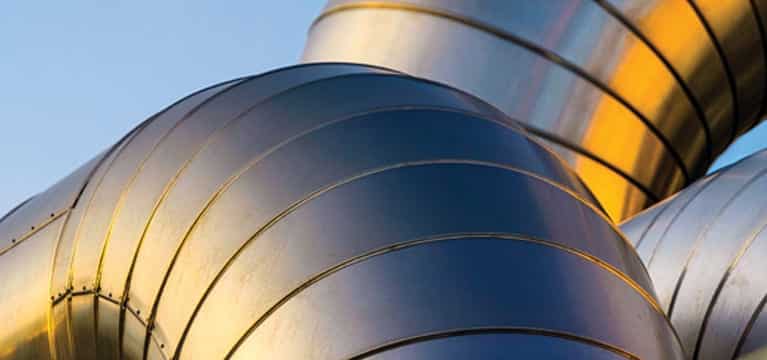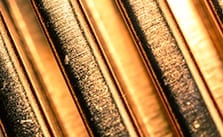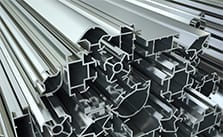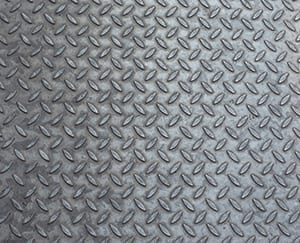by Cynthia Challener, CoatingsTech Contributing Writer
Many areas of the coatings industry are reaping the benefits of radiation-cured coatings. Reduced energy consumption and waste generation, minimal VOCs and environmental impact, smaller footprint, and faster cure times of radiation-cured coatings (overprint varnishes and inks) are realized extensively in the graphic arts industry. Prefinished wood board products, wood furniture and fixtures, and automotive plastic parts are also often protected with radiation-cured (generally ultraviolet, but in some cases electron-beam) coatings. However, there is very limited use of radiation-cured coatings for industrial metal finishing applications. Several factors ranging from the high cost of equipment to concerns about achieving complete cure for varied geometries to simple lack of awareness have contributed to the situation. Interest is growing, however, and now the industrial metal segment is expanding at a faster rate than the overall market for radiation-cured coatings.
Limited But Growing Appeal
In 2013, according to RadTech, the largest usage by volume of UV/EB coatings in North America was for overprint varnishes and inks for graphics arts applications (28 and 21%, respectively), followed by wood (19%), and plastic (8%) coatings. At that time, metal decorating accounted for just 3% of the market. It was, however, the sixth fastest growing UV/EB application with an annual growth rate of 9.3% (3D printing was experiencing the fastest growth rate by far at 27.3%). The overall projected annual growth rate for UV/EB coatings from 2015 to 2017 is 6.7%.
While their use is limited, radiation-cured coatings are recognized as being advantageous in several industrial metal applications. They not only provide corrosion protection and abrasion resistance, but also impart desired appearance (gloss) and functional (anti-fingerprint) properties to many different metal substrates, including aluminum, untreated and phosphate-treated steel, galvanized steel, brass, magnesium, and nickel. The most common examples include coil coatings used on metal for the manufacture of appliances, housings for electronic devices, propane tanks, and metal packaging including aerosol, beverage, general line, food, and specialty cans; temporary and permanent protective coatings for metal pipes and tubes (typically galvanized steel) for fence posts, sprinkler systems, electrical conduit, and mechanical tubing; and protective films for construction steel and aluminum. In addition, radiation-curing technologies have been used for durable coatings for automotive light reflectors, wheel trim, steering wheels, mirrors, roof racks seat frames, truck axles, and more; protective coatings for miscellaneous items ranging from bolts and screws to sports equipment; and abrasion- and heat-resistant coatings for magnetic wires used in engines, transformers, and other electrical components. In these various applications, radiation-cured coatings have been clearly demonstrated to be effective solutions as primers, pigmented basecoats, and topcoats.
Energy-cured coating technology in general is particularly well-suited for high-speed applications, according to Dan Sweetwood, president and CEO of Allied PhotoChemicals. That is why pipe and tube applications are well known. He notes that there are numerous niche applications, such as industrial doors and hardware. His company has also developed UV-cured coatings for specific industrial metal applications under secrecy agreements with customers and therefore cannot provide details. “Ultimately, the decision to choose UV- and EB-curing technology comes down to economics; it must be more efficient than the alternative technologies,” says Sweetwood.
Real Benefits
Many of the benefits of UV/EB-cured coatings for metal applications are similar to the advantages afforded by wood and plastic. Energy-cured coatings generally have enhanced impact, scratch, chemical, and abrasion resistance compared to conventionally cured coatings and low to zero-VOC emissions. Often less waste is generated. Because they do not require heating in ovens, curing temperatures are lower, less energy is consumed, and the manufacturing footprint is smaller. The very rapid cure rate is another key benefit and provides increased throughput and line speeds, which can be very important in many industrial metal coating applications. Together, these benefits add up to increased productivity, lower costs, and higher-performance products. It should also be noted that existing coatings lines can often be readily converted to UV/EB technology.
These various advantages are appreciated to different extents for different applications. “Every manufacturer and application has its own set of criteria that is unique and must be evaluated independently. Energy-cured chemistries are used across the spectrum of applications and the reasons vary, but the most common drivers are enhancements in speed, quality, and performance; cost savings; and environmental benefits,” asserts John Clark, manager for Metal Packaging with Heraeus Noblelight America. For Sweetwood, it is the speed of energy-curing technology that is most important. He notes that currently energy prices are fairly low, and thus the incentive of reduced energy costs has been diminished. “Faster line speeds with smaller footprints are very hard to beat, though,” he asserts. Mark Mielke, business manager for Industrial Coatings with BASF agrees that energy-cured coatings help manufacturers achieve shorter cycle times, often with higher quality finishes, but there is an initial investment in equipment required.
Customers of PCT Engineered Systems use EB-cured coatings on the interiors and exteriors of steel containers, to beautify aluminum building materials, and to protect aluminum components from wear. Along with the elimination of VOCs, the outstanding energy efficiency, and the small footprint of e-beam curing lines, they appreciate the ability to cure heavily pigmented, thick, opaque layers that are difficult or impractical to cure with UV systems, according to Karl E. Swanson, director of Broadbeam Sales and Marketing for the company. “E-beam curing technology is also attracting the attention of mid-sized manufacturers that want to produce coated metal themselves rather than purchase pre-painted coils,” he notes.
Some Challenges Too
Clearly there have been factors hindering the adoption of radiation-cured coatings for industrial metal applications despite their numerous benefits. Overall, according to Michael D. Brown, president of consulting firm StrategyMark, Inc., the adoption of energy-curing technology for industrial metal applications has always been limited by a lack of installed curing capacity, and he has not seen any significant uptick recently. As mentioned previously, the cost of the equipment is one barrier, but Clark believes that this issue must be evaluated on a case-by-case basis. “As long as energy costs remain low,” adds Paul Marshall, technical director for Automotive Refinish at BASF, “the incentive to purchase new equipment will be lacking.”
Another major hindrance to the adoption
of energy-cured coatings for industrial metal applications
is a lack of awareness of the technology.
Others in the industry see bigger hurdles to overcome. “In my view, the most significant challenge is the limited availability of suitable coatings. More options are still needed for this application to reach its potential,” says Swanson. Many manufacturers are also concerned about the ability to achieve complete curing due to complex part geometries, according to Sweetwood. “Radiation curing requires that all surfaces of the coating be exposed to the UV or EB rays. Many industrial metal parts have small shadow areas or are designed such that not all areas can be presented in a way that the light gets sufficiently close to the required surfaces, which may be phenomena unique to metal,” he observes. In some cases it is possible to overcome these issues by using hybrid systems that cure via a combination of a radiation-promoted mechanism and other types of chemistry.
Another major hindrance to the adoption of energy-cured coatings for industrial metal applications is a lack of awareness of the technology. “I would guess that the typical industrial metal manufacturer has never heard of UV coatings,” Sweetwood asserts. He believes that the industry needs to do a better job of promoting the technology. The need for confidentiality has been problematic, however. “Our best applications are often developed under non-disclosure agreements, and our customers don’t want their competitors to know that they are using UV technology. While this situation is a good one because it means that these customers view the technology as a competitive advantage, it can be frustrating, because it makes it harder to promote the technology,” explains Sweetwood.
The Importance of Innovation
While issues such as proprietary developments cannot be overcome with advances in technology, many of the other challenges to the wider adoption of radiation-cured coating for industrial metal applications can be overcome through innovations. In fact, significant progress has been made in the last several years that is likely contributing to the higher-than-average growth rate for UV/EB cured coatings in this segment, according to Sweetwood. “Coating of metal substrates with radiation-cured
formulations is more difficult than the coating of wood. That has contributed somewhat to the slower adoption rates in the past. However, market growth is occurring because manufacturers have a real need to increase efficiency and productivity, and the recent advances in chemistry and curing equipment, combined with the faster line speeds, smaller footprints, and reduced environmental impact of energy technologies, tell a very compelling story,” he comments. Clarks agrees that rapid improvements in both chemistry and curing systems that enhance radiation-curing processes are benefiting end users and suppliers alike.
Newer raw materials include longer wavelength photoinitiators and hyperbranched oligomers and monomers that undergo less shrinkage and therefore provide enhanced adhesion to metals for better corrosion resistance. Significant developments in flexibility, durability, gloss control, abrasion resistance, and other physical characteristics have also been achieved, according to Sweetwood. “All of these improvements are needed, and there continues to be room for improvement. In general, I think the raw material companies are doing a good job of creating next-generation resins,” he notes. Smaller and more economical e-beam systems, including those based on e-beam lamps, have expanded the range of practical applications of EB curing for industrial metal substrates, according to Swanson. He believes that sheetfed e-beam systems will be the next development to expand the number of metal coating applications for this technology. UV-curing systems are also being designed for the curing of coatings on a wider variety of metal parts that require three-dimensional curing techniques. Often these systems are designed in close collaboration with customers and coating formulators in order to develop the most effective solutions. Ultimately, end user demands will continue to drive further developments.
Significant advances in coating raw materials
for LED curing, including resins and photoinitiators,
as well as in LED curing equipment,
have been made in recent years.
A brief mention should be made about LED curing. Significant advances in coating raw materials for LED curing, including resins and photoinitiators, as well as in LED curing equipment, have been made in recent years. According to Marshall, LED curing is attractive because the curing mechanism can be tuned to match a specific wavelength and curing can be achieved without any heat, which saves energy and is less stressful for the substrate. However, Sweetwood notes that the geometry challenges with industrial metal applications do not fit well with LED at this time.
Will Awareness Make the Difference?
There are many advantages to implementing radiation curing technology for industrial metal applications. Adoption of the technology has been limited, but it does appear to be increasing at a healthy rate today. There are multiple reasons for this segment to outperform the overall market for energy-cured coatings, according to Brown. “Industrial manufacturing in general is experiencing a mini-renaissance in the United States, and growth remains fairly strong in emerging markets as well. In addition, the technology seems to finally be moving out of the application development stage to ‘prime time,’ ” he says. Lower raw materials prices may also be a factor. The modernization occurring in many emerging markets, which is accompanied by expansion of the middle class, is another important driver of growth, according to Clark. “The metal packaging market tends to follow a growth curve synonymous with the economic development of a region or country. As disposable incomes increase in emerging markets, consumers tend to purchase more convenience products like beer and other beverages and foods that come in cans manufactured using energy-cured coatings,” he explains.
Brown does note that it is important to keep in mind that with the very small base demand in the industrial metal sector, even minimal growth will register as a large growth rate. Even so, the interest in radiation-curing technology for industrial metal coatings does appear to be increasing. All do agree that one key to making real and measurable gains is to leverage that interest and increase awareness of the technology. “There is a real need for further education in this sector. End users need to be shown all the benefits of UV/EB curing systems and the innovative solutions that are available for their specific applications,” Marshall states.



